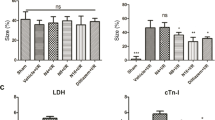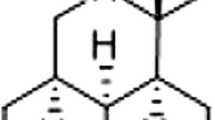Abstract
Noscapine is an antitumor alkaloid derived from Papaver somniferum plants. Our previous study has demonstrated that exposure of noscapine on primary murine fetal cortical neurons exposed to oxygen–glucose deprivation/reperfusion (OGD/R) has neuroprotective effects. In current study, the effects of noscapine on cardiomyocytes (H9c2 cells) damage caused by 120 minutes (min) of OGD/R were evaluated and we determined whether the addition of BD1047, sigma-one receptor antagonist, prevents the protective effects of noscapine in H9c2 cells through the production of nitric oxide (NO) and apoptosis. To initiate OGD, H9c2 cells was transferred to glucose-free DMEM, and placed in a humidified incubation chamber. Cell viability was assessed with noscapine (1–5 μM) in the presence or absence of BD1047, 24 hours (h) after OGD/R. Cell viability, NO production and apoptosis ratio were evaluated by the MTT assay, the Griess method and the quantitative real-time PCR. Noscapine considerably improved the survival of H9c2 cells compared to OGD/R. Also, noscapine was extremely capable of reducing the concentrations of NO and Bax/Bcl-2 ratio expression. While the BD1047 administration alone diminished cell viability and increased the Bax/Bcl-2 ratio and NO levels. The addition of noscapine in the presence of BD1047 did not increase the cell viability relative to noscapine alone. Noscapine exerted cardioprotective effects exposed to OGD/R-induced injury in H9c2 cells, at least partly via attenuation of NO production and Bax/Bcl-2 ratio, which indicates that the sigma-one receptor activation is involved in the protection by noscapine of H9c2 cells injured by OGD/R.




Similar content being viewed by others
References
Li Y-Y, **ang Y, Zhang S et al (2017) Thioredoxin-2 protects against oxygen-glucose deprivation/reperfusion injury by inhibiting autophagy and apoptosis in H9c2 cardiomyocytes. Am J Transl Res 9(3):1471–1482
Zheng K, Sheng Z, Li Y et al (2014) Salidroside inhibits oxygen glucose deprivation (ogd)/re-oxygenation-induced h9c2 cell necrosis through activating of akt–nrf2 signaling. Biochem Biophys Res Commun 451(1):79–85
Kalogeris T, Baines CP, Krenz M et al (2016) Ischemia/Reperfusion. Compr Physiol, Hoboken
Sun N, Yang L, Zhang Q et al (2018) Pioglitazone alleviates oxygen and glucose deprivation-induced injury by up-regulation of miR-454 in H9c2 cells. IJBMS 21(10):1050
Tavakoli-Far B, Rahbar-Roshandel N, Rahimi-Moghaddam P et al (2009) Neuroprotective effects of mebudipine and dibudipine on cerebral oxygen–glucose deprivation/reperfusion injury. Eur J Pharmacol 610(1–3):12–17
Vahabzadeh G, Rahbar-Roshandel N, Ebrahimi S-A et al (2015) Neuroprotective effect of noscapine on cerebral oxygen–glucose deprivation injury. Pharmacol Rep 67(2):281–288
Huang X, Zuo L, Lv Y et al (2016) Asiatic acid attenuates myocardial ischemia/reperfusion injury via Akt/GSK-3β/HIF-1α signaling in rat H9c2 cardiomyocytes. Molecules 21(9):1248
Zhao L, Zhuang J, Wang Y et al (2019) Propofol ameliorates H9c2 cells apoptosis induced by oxygen glucose deprivation and reperfusion injury via inhibiting high levels of mitochondrial fusion and fission. Front Pharmacol 10:61
Dumont M, Lemaire S (1991) Interaction of 1, 3-di (2-[5-3H] tolyl) guanidine with σ2 binding sites in rat heart membrane preparations. Eur J Pharmacol 209(3):245–248
Novakova M, Ela C, Barg J et al (1995) Inotropic action of σ receptor ligands in isolated cardiac myocytes from adult rats. Eur J Pharmacol 286(1):19–30
Gao Q-J, Yang B, Chen J et al (2018) Sigma-1 receptor stimulation with PRE-084 ameliorates myocardial ischemia-reperfusion injury in rats. Chin Med J 131(5):539
Maurice T, Su T-P (2009) The pharmacology of sigma-1 receptors. Pharmacol Ther 124(2):195–206
Stracina T, Novakova M (2018) Cardiac sigma receptors-an update. Physiol Res 67(4):5561–5576
Stracina T, Slaninova I, Polanska H et al (2015) Long-term haloperidol treatment prolongs QT interval and increases expression of sigma 1 and IP3 receptors in guinea pig hearts. Tohoko j Eex Med 236(3):199–207
Zhang H, Cuevas J (2005) σ Receptor activation blocks potassium channels and depresses neuroexcitability in rat intracardiac neurons. J Pharmacol Exp Ther 313(3):1387–1396
Altinoz MA, Topcu G, Hacimuftuoglu A et al (2019) Noscapine, a non-addictive opioid and microtubule-inhibitor in potential treatment of glioblastoma. Neurochem Res 44(8):1–11
Vahabzadeh G, Ebrahimi S-A, Rahbar-Roshandel N et al (2016) The effect of noscapine on oxygen-glucose deprivation on primary murine cortical neurons in high glucose condition. IJPR 15(2):501
Khanmoradi M, Mard SA, Aboutaleb N et al (2014) The protective activity of noscapine on renal ischemia–reperfusion injury in male Wistar rat. IJBMS 17(4):244
Cao A, Li X (2019) Bilobalide protects H9c2 cell from oxygen-glucose-deprivation-caused damage through upregulation of miR-27a. Artif Cells Blood Substit Biotechnol 47(1):2980–2988
Liu J, Sui H, Zhao J et al (2017) Osmotin protects H9c2 cells from simulated ischemia-reperfusion injury through AdipoR1/PI3K/AKT signaling pathway. Front Psychol 8:611
Livak KJ, Schmittgen TD (2001) Analysis of relative gene expression data using real-time quantitative PCR and the 2−ΔΔCT method. Methods 25(4):402–408
**g L, Li Q, He L et al (2017) Protective effect of tempol against hypoxia-induced oxidative stress and apoptosis in H9c2 cells. Med Sci Monit Basic Res 23:159
Li W, Li Y, Sun R et al (2017) Dual character of flavonoids in attenuating and aggravating ischemia-reperfusion-induced myocardial injury. Exp Ther Med 14(2):1307–1314
Liu J, Yang S, Zhang X et al (2016) Isoflurane reduces oxygen-glucose deprivation-induced oxidative, inflammatory, and apoptotic responses in H9c2 cardiomyocytes. Am J Transl Res 8(6):2597
Abdullah CS, Alam S, Aishwarya R et al (2018) Cardiac dysfunction in the sigma 1 receptor knockout mouse associated with impaired mitochondrial dynamics and bioenergetics. J Am Heart Assoc 7(20):e009775
Rousseaux CG, Greene SF (2016) Sigma receptors [σ Rs]: biology in normal and diseased states. J Recept Signal Transduct 36(4):327–388
Novakova M, Bruderova V, Sulova Z et al (2007) Modulation of expression of the sigma receptors in the heart of rat and mouse in normal and pathological conditions. Gen Physiol Biophys 26(2):110–117
Novakova M, Sedlakova B, Sirova M et al (2010) Haloperidol increases expression of the inositol 1, 4, 5-trisphosphate receptors in rat cardiac atria, but not in ventricles. Gen Physiol Biophys 29(4):381
Kamei J, Iwamoto Y, Misawa M et al (1993) Effects of rimcazole, a specific antagonist of σ sites, on the antitussive effects of non-narcotic antitussive drugs. Eur J Pharmacol 242(2):209–211
Vahabzadeh G, Rahbar-Roshandel N, Ebrahimi S-A (2020) Noscapine modulates neuronal response to oxygen-glucose deprivation/reperfusion injury via activation of sigma-1 receptor in primary cortical cultures. IJPR 19(1):331–342. https://doi.org/10.22037/ijpr.2019.112317.13683
Schulz R, Kelm M, Heusch G (2004) Nitric oxide in myocardial ischemia/reperfusion injury. Cardiovasc Res 61(3):402–413
Forstermann U, Sessa WC (2012) Nitric oxide synthases: regulation and function. Eur Heart J 33(7):829–837
Andrew PJ, Mayer B (1999) Enzymatic function of nitric oxide synthases. Cardiovasc Res 43(3):521–531
Taimor G, Hofstaetter B, Piper HM (2000) Apoptosis induction by nitric oxide in adult cardiomyocytes via cGMP-signaling and its impairment after simulated ischemia. Cardiovasc Res 45(3):588–594
Pacher P, Beckman SJ, Liaudet L (2007) Peroxynitrite in Health and Disease, ed. Physiol Rev 87(1):315–424
Wang P, Chen H, Qin H et al (1996) Measurement of nitric oxide and peroxynitrite generation in the postischemic heart. Evidence for peroxynitrite-mediated reperfusion injury. J Biol Chem 271(46):29223–29230
Vagnerova K, Hurn PD, Bhardwaj A et al (2006) Sigma 1 receptor agonists act as neuroprotective drugs through inhibition of inducible nitric oxide synthase. Anesth Analg 103(2):430–434
Bhardwaj A, Sawada M, London ED et al (1998) Potent ~ 1-receptor ligand 4-phenyl-1-(4-phenylbutyl) piperidine modulates basal and N-methyl-D-aspartate-evoked nitric oxide production in vivo. Stroke 29:2404–2410
Zughaier S, Karna P, Stephens D et al (2010) Potent anti-inflammatory activity of novel microtubule-modulating brominated noscapine analogs. PLoS ONE 5(2):e9165
Hofstaetter B, Taimor G, Inserte J et al (2002) Inhibition of apoptotic responses after ischemic stress in isolated hearts and cardiomyocytes. Basic Res Cardiol 97(6):479–488
Ekhterae D, Lin Z, Lundberg MS et al (1999) ARC inhibits cytochrome c release from mitochondria and protects against hypoxia-induced apoptosis in heart-derived H9c2 cells. Circ Res 85(12):e70–e77
Wu W-Y, Wang W-Y, Ma Y-L et al (2013) Sodium tanshinone IIA silate inhibits oxygen-glucose deprivation/recovery-induced cardiomyocyte apoptosis via suppression of the NF-κB/TNF-α pathway. Br J Pharmacol 169(5):1058–1071
Yang C, Li B, Liu Y et al (2019) Ginsenoside Rb1 protects cardiomyocytes from oxygen-glucose deprivation injuries by targeting microRNA-21. Exp Ther Med 17(5):3709–3716
Wang L, Zhang Y, Wan H et al (2017) Glycyrrhetinic acid protects H9c2 cells from oxygen glucose deprivation-induced injury through the PI3K/AKt signaling pathway. J Nat Med 71(1):27–35
Yang S, Bhardwaj A, Cheng J et al (2007) Sigma receptor agonists provide neuroprotection in vitro by preserving bcl-2. Anesth Analg 104(5):1179
Acknowledgement
The authors thank Dr. Mansour Torab for skillful technical assistance.
Funding
This work was supported by Iran University of Medical Sciences (IR.IUMS.REC1393.25042).
Author information
Authors and Affiliations
Corresponding author
Ethics declarations
Conflict of interest
All the authors declared that they have no conflict of interest. No human or animal was used in this study.
Additional information
Publisher's Note
Springer Nature remains neutral with regard to jurisdictional claims in published maps and institutional affiliations.
Rights and permissions
About this article
Cite this article
Vahabzadeh, G., Soltani, H., Barati, M. et al. Noscapine protects the H9c2 cardiomyocytes of rats against oxygen–glucose deprivation/reperfusion injury. Mol Biol Rep 47, 5711–5719 (2020). https://doi.org/10.1007/s11033-020-05549-6
Received:
Accepted:
Published:
Issue Date:
DOI: https://doi.org/10.1007/s11033-020-05549-6




